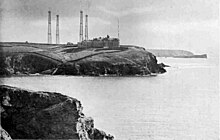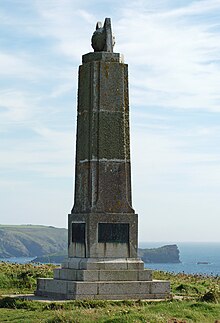Poldhu
Poldhu is an area in south Cornwall , England , on the Lizard Peninsula , about two kilometers from the town of Mullion. It includes the headland of Poldhu Point and Poldhu Cove . The name Poldhu comes from the Cornish language and means "black basin".
Marconi's Poldhu radio station
The place Poldhu became famous for the radio station built here. With the transmitter built by Guglielmo Marconi, transatlantic radio transmission was made possible for the first time on December 12, 1901 . The signal broadcast from here was received by Marconi at the receiving station on Signal Hill near St. John's in Newfoundland . The transmitted signal, repeated three short tones, an "S" in Morse code , overcame a distance of about 3400 kilometers. On December 17, 1902, Marconi was able to exchange the first transatlantic test message in both directions between Poldhu and Glace Bay in Nova Scotia, Canada, and a month later he succeeded in making the first public telegraph between Poldhu and the Marconi Wireless Station Site in Wellfleet on the Cape Cod peninsula in Massachusetts : Greetings between US President Theodore Roosevelt and the King of England Edward VII.
Construction of the approximately 200,000 m² large station, designed by John Ambrose Fleming , began in October 1900 and was completed in January 1901. The work was carried out by the Marconi Company . Marconi had chosen this place near the cliffs because it was open to the west to allow transmission across the Atlantic . Furthermore, he was so remote that he could work here undisturbed by reporters, and the Poldhu Hotel in the immediate vicinity made it possible for his work group to be accommodated on site. The originally planned antenna system, with 20 masts each 61 meters high, which stood in a circle around the transmitter and were guyed with 400 ropes, was destroyed by a storm on September 17, 1901, before the actual experiment. Within a week, a makeshift antenna with two masts was installed to carry out the transmission.
The transmitter had an output of 13,000 watts and transmitted with a wavelength of 170 m, which corresponds to about 1.76 MHz . The initially planned mast arrangement was not rebuilt later either, instead four large 66 m high wooden masts were erected to which the antenna was attached. In 1903 the Prince of Wales and his wife toured the facility. The later King George V even climbed one of the antenna towers that day. Subsequently, the former research station was mainly used commercially.
Marconi later used the system for his shortwave experiments when he carried out transmissions from here to the yacht Elettra on the Cape Verde Islands in 1923 and to Beirut in 1924. The groundbreaking results of these experiments contributed to the rapid spread of radio communication around the world.
The station was in operation until 1933. In 1935 parts were demolished and about 24,000 m² went to the National Trust in 1937 , the rest of the complex was taken over by the National Trust in 1960 and placed under its protection. Concrete foundations have been preserved from the old systems. In 2001 a new museum building was erected to commemorate the 100th anniversary of the first transatlantic radio transmission. A monument has also been erected on site to commemorate the pioneering work of Marconi and his employees. On one of the four panels on the monument is the text: “One hundred yards north east of this column stood from 1900 to 1933 the famous Poldhu wireless station, designed by John Ambrose Fleming and erected by the Marconi Company of London, from which were transmitted the first signals ever conveyed across the Atlantic by wireless telegraphy. The signals consisted of a repetition of the Morse letter 'S' and were received at St. John's, Newfoundland, by Guglielmo Marconi and his British associates on 12.12.1901. "
The building of the former Poldhu Hotel still exists and currently houses a nursing home. The antenna systems that are on the site today are operated by the Poldhu Amateur Radio Club .
Web links
- MarconiCalling an interactive presentation about Guglielmo Marconi
- Pictures and descriptions of the facility
- BBC reports on the construction of the museum (2001)
Coordinates: 50 ° 1 ′ 47 " N , 5 ° 15 ′ 55" W.



